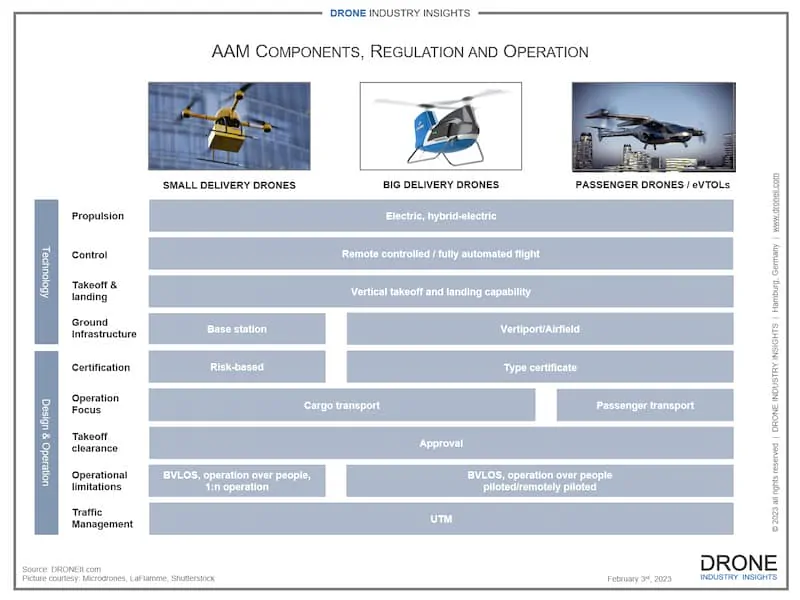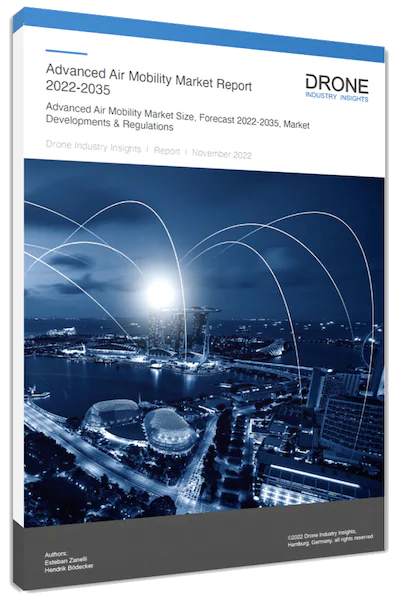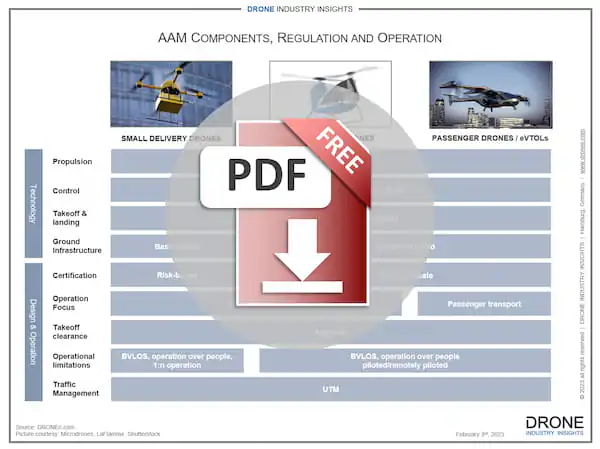

Vision of Advanced Air Mobility: eVTOLs, Drone Delivery, Vertiports and UTM
The Advanced Air Mobility (AAM) industry is set to grow to US$20.8 billion by 2035 at a CAGR (compound annual growth rate) of 22.1%. The concept of electric Vertical Take-off and Landing (eVTOL) vehicles and delivery drones may be a fresh and exciting idea for most of the world. Yet for those who are well-versed in the field of drones and air mobility, the rapid advancements in Advanced Air Mobility (AAM) are nothing new.
AAM is an overarching term that combines both Urban Air Mobility (UAM), which involves transporting persons and cargo above the traffic within a city, and Regional Air Mobility (RAM) which is focused more on connecting suburbs, villages and small towns in the countryside as well as islands or communities separated by mountainous regions and rivers. Next to eVTOLs, AAM only works in an ecosystem that includes physical and communication infrastructures such as vertiports and Unmanned Traffic Management (UTM) systems. Though it’s hard to summarize the nitty-gritty details of AAM and how the industry got to where it is, let’s take a closer look at the cutting-edge technology driving this revolution.
eVTOLs, Passenger Drones and Air Taxis
Electric Vertical Takeoff and Landing vehicles, or eVTOLs, represent a new and innovative approach to air mobility and aviation design compared to traditional helicopters. With over 600 concepts from over 350 companies, the AAM space is rapidly growing. Currently, 5% of these concepts are in the test phase, which is the preliminary stage of the certification process. To be widely accepted for use in densely populated areas, eVTOLs must meet several important requirements, including safety, noise reduction, efficiency, cost-effectiveness, and eco-friendliness.
Over time, the design of eVTOLs has advanced from pure multirotor configurations to augmented lift, vectored thrust, and lift-and-cruise configurations. These designs aim to use aerodynamic lift from small wings to fly more efficiently over long distances, while still maintaining compactness and weight savings through the use of multirotor configurations for short distances. In addition, reducing noise through the use of distributed electric propulsion and computational fluid dynamics is a priority, as eVTOLs will operate in urban areas.
In terms of weight, eVTOLs aim to be much lighter than traditional helicopters, despite the added weight of batteries. Most manufacturers are targeting certification under FAA Part 27/29, with a maximum takeoff weight of 3,175kg and the ability to carry up to nine passengers. Range is a central point of discussion in the eVTOL industry, with manufacturers aiming for ranges of up to 500 km, although the required specific battery capacity does not yet exist. On average, manufacturers aim for four-seat eVTOLs – comparable to a private car.
– Our AAM Report covers these and other eVTOL topics such as: terminology for eVTOL / passenger drone / air taxi, operating rules and certification requirements, funding, development stage, propulsion system and battery capacities / weight / flight time as well as requirement, handling and costs… overview of social acceptance studies, timeline and milestones, technical improvements, and outlook.
Drone Delivery: Small and Big Cargo
Drone delivery was and is one of the focal points when people talk about the drone industry. However, the answer to the question: “Will my Pizza soon come by drone?” in most cases will for the foreseeable time be ”not likely”. Last-mile drone delivery is very complex – other delivery scenarios (e.g. delivery to a small packaging station) are more likely, especially in densely populated city centers. Nevertheless, in the suburbs and rural areas, drones already deliver retail, food and medical supplies to “the doorstep” today.
The first drone deliveries to take off have been those carrying medical goods. They are proving to be transformative for under-developed countries like Rwanda, Ghana, Vanuatu, and soon India and the Democratic Republic of Congo test and conduct medical drone deliveries. In more western countries, Switzerland has employed them for two years, testing organ transplant deliveries while several countries have already enjoyed food deliveries by drone including Iceland, Finland, Australia, the United States and many more. Finally, as e-commerce and postal service giants like Walmart, Amazon, Rakuten, JD.com enter the drone delivery market, retail goods and industrial materials are beginning to be delivered by drone.
When there is no or strongly limited access to infrastructure, big cargo drones offer most value. Transporting cargo to remote places (e.g. off-shore oil rigs, islands, etc.) often requires slow and costly solutions. Large cargo drones can leapfrog the price-intensive construction of ground infrastructure (e.g. a new road, train track or ferry slips) and deliver goods directly to the point of consumption. However, the combination between direct, first-mile/last-mile, mid-mile/feeder, and hub forwarding will be a key component for the logistics and success of drone delivery.
– On drone delivery, our Advanced Air Mobility Report features: market sectors (food, retail, industrial, medical), business models, financials and partners, payload-vs-range performance covers these and other eVTOL topics such as: terminology for eVTOL / passenger drone / air taxi, operating rules and certification requirements, funding, development stage, propulsion system and battery capacities/weight/flightTime as well as requirement, handling and costs… overview of social acceptance studies, timeline and milestones, technical improvements, and outlook.
Vertiports and Landing Pads
To fully realize their potential, eVTOLs and delivery drones will depend on the availability of proper physical infrastructure, specifically vertiports. Vertiports serve as hubs and provide the necessary infrastructure for takeoff and landing, recharging, maintenance, and storage. The design and capabilities of vertiports will play a crucial role in ensuring the safety, efficiency, and sustainability of AAM, making them an integral part of the future of air mobility and transportation as a whole.
There are several types of ground infrastructures such as: drone landing pads/stations, drone cargo hubs, verti-pads/verti-stops, verti-hubs and AAM-bubs, all of which have different capacities and fulfill different needs for eVTOLs and delivery/cargo drones. Among the top issues to consider are location, noise mitigation, power supply, maintenance, and any additional value to society that the vertiports would bring (e.g. shops, food, etc). This is perhaps one reason why all existing requirements for vertiport design are currently published as draft versions rather than complete regulations.
– AAM Report includes: detailed look at vertiport types, top applications and candidate locations for eVTOL and cargo, market players, and global pilot projects
Want to Know More About Advanced Air Mobility? Check Out Our New AAM Report!
Advanced Air Mobility (AAM) Report 2022-2035
• Extensive 111-page Advanced Air Mobility Report with in-depth analysis and information
• Air taxis/eVTOLs/Passenger Drones
• Delivery/Cargo Drones
• Vertiports
• UTM
• Exclusive data on market size derived specifically for the Advanced Air Mobility Report
UTM – Unmanned Traffic Management
Much like vertiports, Unmanned Traffic Management (UTM) is a critical tool for managing the growing number of eVTOL and drone operations in shared and segregated airspace. It serves as a cooperative platform for stakeholders such as drone operators, National Aviation Authorities (NAA), Air Navigation Service Providers (ANSP), and traditional Air Traffic Management (ATM) to determine and communicate real-time airspace status for drones of all sizes. UTM helps ensure the safety of low-altitude drone operations and enables permanent broadcasting of drone position and communication between drones, manned aircraft, operators, and ANSPs.
At its core, UTM includes several core elements, including registration, strategic deconfliction, monitoring and alerting, tactical deconfliction, and remote identification. During the registration process, drone operators, pilots, and drones are registered with the required information in accordance with local regulations. Strategic deconfliction assesses and schedules flight plans to ensure safe distances from other airspace users, while monitoring and alerting provides live monitoring of individual flights and alerts operators and other airspace users in the event of deviations from the agreed plan. Tactical deconfliction allows for modifications to the flight plan during the flight in response to unplanned airspace events, and remote identification identifies the drone in operation and provides information about its speed, position, and direction.
UTM plays a critical role in managing drone traffic in controlled airspace and will eventually manage BVLOS flights in non-segregated airspace. The ultimate goal of UTM is to support ANSPs in maintaining a safe airspace and provide the necessary infrastructure for safe and efficient air mobility and drone operations. The development of UTM will continue to evolve as the number of drone operations increases, and it will be essential for the sustainable growth of AAM.
– In AAM Report: UTM goals, architecture, implementation status, timeline, framework comparison, UTM standards, market players, global trial programs
AAM: Advanced Air Mobility: from Vision to Reality
The promise of Advanced Air Mobility is irresistible: clean, cheap air transportation, instantly summoned with the tap of a finger on a smartphone. That vision is fueling a worldwide boom in eVTOL prototypes, with new aircraft emerging from hangars seemingly every month. The vision to fly above these traffic jams in a quick and ecologically-friendly pod is tempting and one of the main drivers for this industry. But it doesn’t stop there. Logistics – both Hub-to-Hub, as well as first and last mile delivery – using fully automated platforms to connect centers all the way up to end clients, is an almost too-good-to-be-true scenario.
Nevertheless, a lot still has to happen before this vision is a reality. Given the inseparable nature of AAM with a heavily-regulated aviation industry, everything from the vehicles, delivery drones, vertiports and UTM systems to coordinate flights still has to go through a lengthy and imperative process of testing and certification. Only this will ensure the safety of both the skies and everything underneath. So, despite the general public’s fascination with this vision, and the eagerness from investors to profit from its entry into market, the road to safe and efficient air mobility still faces some speed bumps and yield signs. And yet there is no denying that it is very much a green light ahead.
– The Advanced Air Mobility (AAM) Report 2022-2035 features all segments above including market sizes and forecast broken down by segment (i.e. Passenger Services, Small Cargo Services, Big Cargo Services, Hardware, Aftermarket, Other Services), by region, and by country
Download our FREE AAM Infographic
This infographic, “Advanced Air Mobility AAM Infographic”, shows the key components of AAM such as eVTOLs, Drone Delivery, Vertiports, UTM and how they interact in regulation and operations

Before working with drones, Ed acquired vast experience in Communications and Diplomacy. He holds a Master’s in International Relations, Bachelor’s in Economics & Philosophy, and has lived in 7 countries.



